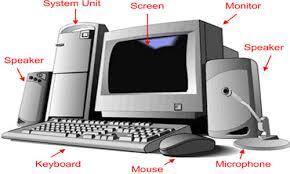Introduction to computer
A computer is an electronic machine that processes raw data to give information as output.
An electronic device that accepts data as input, and transforms it under the influence of a set of special instructions called Programs, to produce the desired output (referred to as Information).
Explanations;
A computer is described as an electronic device because; it is made up of electronic components and uses electric energy (such as electricity) to operate.
A computer has an internal memory, which stores data & instructions temporarily awaiting processing, and even holds the intermediate result (information) before it is communicated to the recipients through the Output devices.
It works on the data using the instructions issued, means that, the computer cannot do any useful job on its own. It can only work as per the set of instructions issued.
A computer will accept data in one form and produce it in another form. The data is normally held within the computer as it is being processed.
Program:
A computer Program is a set of related instructions written in the language of the computer & is used to make the computer perform a specific task (or, to direct the computer on what to do).
A set of related instructions which specify how the data is to be processed.
A set of instructions used to guide a computer through a process.
Data: Is a collection of raw facts, figures or instructions that do not have much meaning to the user.
Data may be in form of numbers, alphabets/letters or symbols, and can be processed to produce information.
TYPES OF DATA.
There are two types/forms of data:
a). Digital (discrete) data:
Digital data is discrete in nature. It must be represented in form of numbers, alphabets or symbols for it to be processed by a computer. Digital data is obtained by counting. E.g. 1, 2, 3 …
b). Analogue (continuous) data:
Analogue data is continuous in nature. It must be represented in physical nature in order to be processed by the computer. Analogue data is obtained by measurement. E.g. Pressure, Temperature, Humidity, Lengths or currents, etc. The output is in form of smooth graphs from which the data can be read.
Data Processing:
It is the process of collecting all items of data together & converting them into information.
Processing refers to the way the data is manipulated (or handled) to turn it into information.
The processing may involve calculation, comparison or any other logic to produce the required result. The processing of the data usually results in some meaningful information being produced.
Information: is the data which has been refined, summarized & manipulated in the way you want it, or into a more meaningful form for decision-making. The information must be accurate, timely, complete and relevant

👍👍
ReplyDeleteNyc
ReplyDeleteTnx u😊
Deletevery knowledgeable vedio 👍
ReplyDeleteTnx u 😊
DeleteWell done
ReplyDeleteExcellent
ReplyDeleteAtttt
ReplyDeleteNyc
ReplyDeleteExcellent
ReplyDeleteNice 👍
ReplyDelete